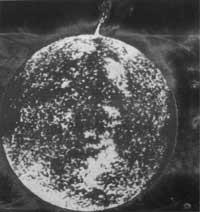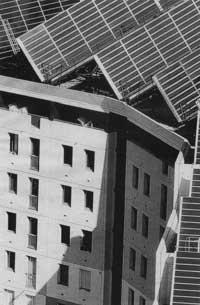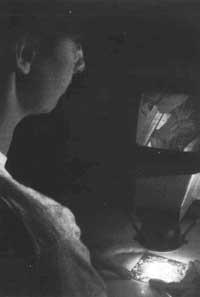The future of solar energy
Last year at UNESCO Headquarters in Paris, experts from around the world analysed the evolution of solar energy until 2005. It is interesting to know the current situation in photovoltaic cells. Surprisingly, the sector that manufactures and uses most non-subsidized cells is the smallest calculator in Japan. Another field is the industrial panels made up of photovoltaic cells that take advantage of solar energy on the roofs of houses.
Solar panels

The performance of photovoltaic plates is normally 14%, that is, the plate provides as electrical energy 14% of all heat energy obtained from the sun. Researchers usually achieve 20% laboratory performance and with the help of sophisticated systems they can reach between 30 and 40%.
Currently the photovoltaic energy in the world of the coast i is employed around twenty billion pesetas (billion pounds). This amount is not significant compared to that used for other types of energy, such as that used for thermonuclear fusion research, but it is expected that within a few decades 10% of the energy consumed in developed countries will be solar. However, in developing countries and countries where the sun hits strongly, this percentage will be much higher.
The use of solar panels began fifteen years ago, but are now used to feed thousands of pumps, refrigerators, lamps and communication systems.
Currently more than 30,000 houses have solar panels on their roofs. In the United States there are also power stations of up to eight megawatts that try to introduce their production into the electricity grid.
Advantages and disadvantages
Global production of photovoltaic cells increases by 20-30% each year and doubles in four years. Formerly the photovoltaic energy caused great dreams. Some thought it would be the substitute for nuclear energy, but according to the Basque saying, the belief corrupt half. Photovoltaic energy has great advantages. The generators are quiet, clean, maintenance-free, water-free and mechanical parts free. In addition, the material for the manufacture of these cells (silica) is very abundant, representing 20% of the earth's surface.
However, it cannot be denied that there are disadvantages. These plates also worked during the day, and production depends on the intensity of the sun's rays, i.e. higher in summer and lower in winter. Place large surface panels. In Euskal Herria, for example, at noon the square meter module provides a power of about 100 watts. Comparing costs, each watt produced by the panel is more expensive than that produced in large thermal power plants, and much more expensive than that produced in hydroelectric power plants.

However, there are territories where these comparisons are not possible. In the Sahara desert area, for example, there are numerous isolated cores without connection to the power grid. Those living isolated on the mountain, remote weather stations and some points away from the power grid are suitable for placing these panels. When electricity is needed in these places, the option is to install photovoltaic panels, a diesel generator, dry batteries Ia. Undoubtedly, the most ecological option is that of photovoltaic panels. This is why grants are granted for research by scientists.
Three lines of research
Research is conducted mainly in three different ways. The first is to improve the possibility of monocrystalline or polycrystalline silicon. The goal is to reduce performance losses at all stages of the process. In semiconductor physics it is necessary to improve the electron/hole separation. Try new thinning systems of silicon sheets. In the cutting systems currently used half of the material is wasted and in addition the foil is finally too thick. A sheet of 150 microns comes out and it would be enough with 30 microns. A new system consists of applying a thin layer of silicon from the steam or liquid phase. Astropower from New Jersey offers 120 watt modules with 18 675 cm 2 cells produced by this procedure.
In each of these cells, when the photon touches the electron, it is released from the atom. Then we have a negative charge free electron and a positive charge “hole”. If the procedure is continuous and it is possible to orient the circulation of electrons, it is possible to convert heat into electric current. The problem is to prevent the free electron from sitting in another “hole.” This is how photovoltaic cells work. All are sandwich shaped. In the center is the silicon membrane called intrinsic (i).
Towards the sun there is a thin layer of silicon (p) doped in boron. The boron atom has three electrons in the outer layer and silicon four. It has a membrane (n) doped on the opposite side of the sun with phosphorus or arsenic (five electrons in the outer layer of the atom). This system (link in p-i) separates electrons and “holes” released by photons by an electric field. An electric current is generated that is stored in two electrodes. One of them is transparent and connects to the face of the sun. The other is metallic and fixed to the encapsulated resin.
Links in p-i and multiple links are currently being studied to improve performance.
The second line of research is that of amorphous silicon. When they discovered that a thin layer of messy amorphous silicon could have characteristics of semiconductors doped with 10 hydrogen, scientists were hopeful in the 1980s. Crystal silicon technology will work by taking advantage of the residues of the microelectronics industry. It is a silicon that is discarded for not having sufficient purity for electronic circuits. Despite efforts to manufacture less pure silicon for the solar panel, costs are high and the photovoltaic cell manufacturing industries fear its scarcity. Currently they consume around 600 tons of silicon per year, but in 2000 1% of the world's electricity consumption is solar, 1 80,000 tons are needed.

However, from the silane gas in the plasma reactor current can be obtained with layers of a single micron of silicon and less material would be consumed. That is why scientists have begun to investigate this path. Problems soon appear. For example, the yield is 3 to 5%. It is expected that within a few years the yield will be 10 and that the price will be reduced considerably.
The third line of research includes all those alternatives to the previous two. Other non-silicon materials, such as iron sulfide, cadmium teluride, copper/indian/diselenium sandwiches, etc. In fact, they would have higher yields and if thin layers of cheap electrochemical techniques can be obtained (by baths). Problems are due to ignorance of these materials and ignorance of the pollution they can generate.
In today's cells, many of the collected photons are too energetic. Therefore, the use of successive gallium arsenide/indian/phosphorus cells would eliminate the maximum energy from solar rays, since each material is specialized for a certain energy level. The installation of fresnel lenses and light concentration on a small surface significantly improve performance. The first sessions of this technique have been done with two stacked cells, but they will also start with four.
By controlling the layers at the atom level, the high purity materials must be carefully deposited so that the yield is 40% i. Recently Boeing has achieved a 30% performance with this type of cells in tandem and in space environment. Research is being done for satellites, as improving performance releases less weight or more power. It is expected that one day solar power plants will be installed in the space.
Today, two billion people in the world live far from the power grid (especially in the Third World) and there is the photovoltaic cell market. The connection of the panels, the regulator, the converter and the battery will allow to have electric power. Especially in Africa and India they have a lot of interest in this issue.





